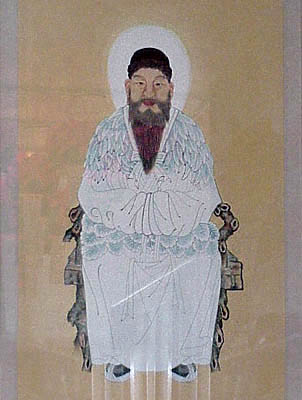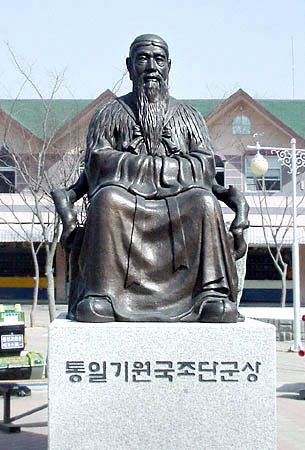Movements - 21
Ready Posture - PARALLEL READY STANCE |
| 1. |
Draw, both hands big draw to 3 oclock.
Step to Left Back Stance to 9 oclock, Left Check and KIAI
|
| 2. |
Roll hands over, step, Right Punch. |
| 3. |
Draw, both hands big draw to 9 oclock.
Step to Right Back Stance to 3 oclock, Right Check. |
| 4. |
Roll hands over, step, Left Punch. |
| 5. |
Draw, Left hand to right ear.
Step to Left Forward Stance to 12 oclock, Left Downward
Block. |
| 6. |
Lift, step, Right Punch. |
| 7. |
Lift, step, Left Punch. |
| 8. |
Lift, step, Right Punch and KIAI |
| 9. |
Down X-block, Right hand on top.
Step to Left Back Stance to 3 oclock and C-Block. |
| 10. |
Roll over, step Right Punch. |
| 11. |
Down X-block, Left hand on top.
Step to Right Back Stance to 9 oclock and C-Block. |
| 12. |
Roll over, step Right Punch. |
| 13. |
Draw Left hand to right ear.
Step to Left Front to 6 oclock and Left Downward Block.
|
| 14. |
Left Rising Block. |
| 15. |
Step to Right Forward Stance and Right Rising
Block. |
| 16. |
Step to Left Forward Stance and Left Rising
Block. |
| 17. |
Step to Right Forward Stance and Right Rising
Block. |
| 18. |
Draw Left Open hand to Right Ear.
Step to Left Back Stance to 9 oclock and Left Shuto Strike.
|
| 19. |
Roll over, step Right Punch. |
| 20. |
Draw Right Open hand to Left Ear.
Step to Right Back Stance to 3 oclock and Right Shuto Strike. |
| 21. |
Roll over, step Left Punch and KIAI |
| END: Bring the left foot back to a ready posture. |
The Legend of Tan-Gun
The legend of Dan-Gun was first recorded by the 12th century
scholar-statesman-general Kim Pu-Sik in his historical work
Sam-Guk-Sagi, Annals of the Three Kingdoms. It is considered
to be the earliest and the most important surviving source of
history on the three kingdoms of Korea. In the face of continual
threats of foreign domination the legend of Dan-Gun was often
instrumental in reviving national unity after the 12th century.
In 1909 it again increased in popularity in the form of the
Tae-Jong-Gyo, or Great Dan-Gun Teaching. The legend of
Dan-Gun concerns the earliest Korean people, believed to have
come from present day Manchuria, northern China, and Mongo lia. These people eventually
formed tribal leagues which collectively became ancient Korea
or Chosun, literally meaning "Land of the Morning Calm."
Manchuria, northern China, and Mongo lia. These people eventually
formed tribal leagues which collectively became ancient Korea
or Chosun, literally meaning "Land of the Morning Calm."
They ruled the territory between the Liac River in southern
Manchuria and the Taedong River in central north Korea. Among
these people, the most powerful clan was the Bear Totem family,
which provided most of the rules for this tribal league. This
may have had some influence on the part of the bear in the Legend
of Dan-Gun.
He gathered these spirits under the Pak-Tal (Sandalwood) Tree
and declared himself the King of the Universe. Although he governed
this kingdom with the help of the "Wind General,"
the "Rain Governor," and the "Cloud Teacher,"
he realized that he someday would need to be in a human form
in order to reign over a human kingdom. This need was fulfilled
when one day Whan-Ung overheard a bear and a tiger who said,
"Would that we might become men." Whan-Ung said to
them, "Here are 20 pieces of garlic and a stick of artermisia
(a type of sagebrush) for each of you. Eat them and retire from
the sunlight for 21 days and you will become men." Both
did as they were told and retreated into a cave. The tiger,
because of his fierceness of nature, could not endure
the entire 21 days and came out. The bear, with greater patience
and faith, stayed for the duration and was transformed into
a perfect woman. Her first wish was for motherhood, and she
cried out, "Give me a son!" At that moment, Whan-Ung
was passing by on the wind and saw her sitting by a stream.
He circled around her, breathed on her, and she became pregnant.
Her son was born on Mount Myo-Hyang under the
Pak-Tal Tree and was named Dan Gun Wang-Gum, Lord of the Pak-Tal
Tree. Years later, man of the " nine wild tribes,"
called the Ku-I, found him sitting under the Pak-Tal fond of
dancing, ( Myo-Hyang-fjellet ) drinking, and singing. They wore
clothes made with grasses and ate fruits, berries, nuts, and
roots. They lived beneath the trees during the summer and in
holes in the ground in the winter. Into their simple life Dan-Gun
was said  to
have introduced the rite of marriage, the subject king relationship,
the arts of cooking and house building, cutting of trees and
agriculture, and how to bind up their hair with cloth. He also
introduced religious worship and is said to
have built the first altar on Kang-Wha Island in 2265 B.C. This
altar today on top of the island's highest peak, Muni-San, and
is known as Dan-Gun's Altar. Dan-Gun lived with his wife Pi
So-Ap and his sons, who are said to have built the fortress
of Sam- Nang at Chung-Dung Island.
to
have introduced the rite of marriage, the subject king relationship,
the arts of cooking and house building, cutting of trees and
agriculture, and how to bind up their hair with cloth. He also
introduced religious worship and is said to
have built the first altar on Kang-Wha Island in 2265 B.C. This
altar today on top of the island's highest peak, Muni-San, and
is known as Dan-Gun's Altar. Dan-Gun lived with his wife Pi
So-Ap and his sons, who are said to have built the fortress
of Sam- Nang at Chung-Dung Island.
In 1122 the uncle of the Shang King of China, Ki-Ja, escaped
the overthrow Shang Dynasty and migrated to Korea with 5000
followers. According to the legend, after reigning for 1,211
years, Dan-Gun fled from the Ki-Ja forces to the town of Mun-Wha,
resumed his spirit form, and disappeared from the earth. The
shrine to the "Trinity" in what today contains his
410-footcircumference "grave." The Ki-Ja assumed the
rule of Korea from 1122 B.C. to 193 B.C., teaching the people
Chinese culture in the form of letters, reading, writing, medicine,
and art.
Since the word "Gom" means both King and Bear in
old Korean languages, it is not unnatural for this legend to
have originated during the more primitive culture of Korea.
Modern Korea celebrates October 3rd as Dan-Gun Day in memory
of the holy founder of Korea and the South Korean government
has established the year 2333 B.C. as the birth date of Korea.
Print
Pattern and History - 8/13/02